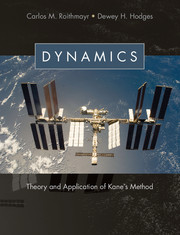Book contents
- Frontmatter
- Contents
- Preface
- Preface to Dynamics: Theory and Applications
- To the Reader
- 1 Differentiation of Vectors
- 2 Kinematics
- 3 Constraints
- 4 Mass Distribution
- 5 Generalized Forces
- 6 Constraint Forces, Constraint Torques
- 7 Energy Functions
- 8 Formulation of Equations of Motion
- 9 Extraction of Information from Equations of Motion
- 10 Kinematics of Orientation
- Problem Sets
- Appendix I Direction Cosines as Functions of Orientation Angles
- Appendix II Kinematical Differential Equations in Terms of Orientation Angles
- Appendix III Inertia Properties of Uniform Bodies
- Index
Preface to Dynamics: Theory and Applications
Published online by Cambridge University Press: 05 February 2016
- Frontmatter
- Contents
- Preface
- Preface to Dynamics: Theory and Applications
- To the Reader
- 1 Differentiation of Vectors
- 2 Kinematics
- 3 Constraints
- 4 Mass Distribution
- 5 Generalized Forces
- 6 Constraint Forces, Constraint Torques
- 7 Energy Functions
- 8 Formulation of Equations of Motion
- 9 Extraction of Information from Equations of Motion
- 10 Kinematics of Orientation
- Problem Sets
- Appendix I Direction Cosines as Functions of Orientation Angles
- Appendix II Kinematical Differential Equations in Terms of Orientation Angles
- Appendix III Inertia Properties of Uniform Bodies
- Index
Summary
Dissatisfaction with available graduate-level textbooks on the subject of dynamics has been widespread throughout the engineering and physics communities for some years among teachers, students, and employers of university graduates; furthermore, this dissatisfaction is growing at the present time. A major reason for this is that engineering graduates entering industry with advanced degrees, when asked to solve dynamics problems arising in fields such as multibody spacecraft attitude control, robotics, and design of complex mechanical devices, find that their education in dynamics, based on the textbooks currently in print, has not equipped them adequately to perform the tasks confronting them. Similarly, physics graduates often discover that, in their education, so much emphasis was placed on preparation for the study of quantum mechanics, and the subject of rigid body dynamics was slighted to such an extent, that they are handicapped, both in industry and in academic research, by their inability to design certain types of experimental equipment, such as a particle detector that is to be mounted on a planetary satellite. In this connection, the ability to analyze the effects of detector scanning motions on the attitude motion of the satellite is just as important as knowledge of the physics of the detection process itself. Moreover, the graduates in question often are totally unaware of the deficiencies in their dynamics education. How did this state of affairs come into being, and is there a remedy?
For the most part, traditional dynamics texts deal with the exposition of eighteenth-century methods and their application to physically simple systems, such as the spinning top with a fixed point, the double pendulum, and so forth. The reason for this is that, prior to the advent of computers, one was justified in demanding no more of students than the ability to formulate equations of motion for such simple systems, for one could not hope to extract useful information from the equations governing the motions of more complex systems. Indeed, considerable ingenuity and a rather extensive knowledge of mathematics were required to analyze even simple systems. Not surprisingly, therefore, ever more attention came to be focused on analytical intricacies of the mathematics of dynamics, while the process of formulating equations of motion came to be regarded as a rather routine matter. Now that computers enable one to extract highly valuable information from large sets of complicated equations of motion, all this has changed.
- Type
- Chapter
- Information
- DynamicsTheory and Application of Kane’s Method, pp. xi - xivPublisher: Cambridge University PressPrint publication year: 2016



